
About UsThe Numismatic Bibliomania Society is a non-profit organization promoting numismatic literature. For more information please see our web site at coinbooks.org SubscriptionsThose wishing to become new E-Sylum subscribers (or wishing to Unsubscribe) can go to the following web page link MembershipThere is a membership application available on the web site Membership Application To join, print the application and return it with your check to the address printed on the application. Membership is only $20 to addresses in the U.S., $25 for First Class mail, and $30 elsewhere. For those without web access, write to: David M. Sundman, Treasurer AsylumFor Asylum mailing address changes and other membership questions, contact David at this email address: dsundman@LittletonCoin.com SubmissionsTo submit items for publication in The E-Sylum, just Reply to this message, or write to the Editor at this address: whomren@gmail.com
BUY THE BOOK BEFORE THE COIN |
- WAYNE'S WORDS: THE E-SYLUM AUGUST 10, 2014
- LAKE BOOKS SALE #119 CLOSES SEPTEMBER 9, 2014
- SELECTIONS FROM THE 2014 KOLBE & FANNING FIXED PRICE LIST
- 2014 NUMISMATIC LITERARY GUILD AWARD WINNERS
- OROSZ REVIEWS LUPIA'S NUMISMATIC BIBLIOGRAPHY
- NEW ORLEANS BANKNOTES RECYCLED IN RESPONSE TO THEFT
- MORE ON COL. ROBERT C.H. BROCK
- NOTES FROM E-SYLUM READERS: AUGUST 10, 2014
- GOLD KENNEDY PROXY BUYERS LINE UP AT DENVER MINT
- CROWD TRAMPLED AT DENVER MINT GOLD KENNEDY LINE
- FIRST GOLD KENNEDY HALF DOLLAR RESOLD FOR $100,000
- BUYERS OF FIRST FOUR GOLD KENNEDYS SELL FOR $20,000
- THE AMMENITIES OF COIN COLLECTORS
- KÜNKER MOVED TO NEW QUARTERS
- ARTICLE FEATURES CANADIAN WHITE-TAILED DEER COIN ARTIST
- THE GROWTH OF NON-CIRCULATING LEGAL TENDER COINAGE
- WAYNE'S NUMISMATIC DIARY: AUGUST 10, 2014
- GETTING YOUR NUMISMATIC BOOK IN PRINT
- THE VERY FIRST STEAM COINAGE MEDAL
- ELECTRA WAGGONER BIGGS AND MEDALLIC ART COMPANY
- 1877 HALF UNION PATTERN IN GILT COPPER
- OMSA MEDAL QUIZ ANSWERS
- WEISS ANCIENT COINS RETURNED TO GREECE
- GREAT REVOLT COIN HOARD UNCOVERED IN JERUSALEM
- CONDEMNED FLORIDA HOME SPEWS COINS FROM WALLS
- SMITHSONIAN INSTITUTION FOUNDED IN 1846
- FEATURED WEB PAGE: NATIONAL NUMISMATIC COLLECTION
Click here to access the complete archive
To comment or submit articles, reply to whomren@gmail.com
WAYNE'S WORDS: THE E-SYLUM AUGUST 10, 2014

New subscribers this week include: Charmy Harker, Moses Aguilar, James Reinders, and Cedrian Lopez-Bosch. Welcome aboard! We now have 1,756 subscribers.
This week we open with a note form Fred Lake, selections from the Kolbe & Fanning Fixed Price List, NLG Award winners, and a review of John Lupia's update of Numigraphics.
Other topics include recycled obsolete bank notes, the gold Kennedy fiasco, manners for coin people, NCLT, the first U.S. steam coinage, and the National Numismatic Collection.
To learn more about the Maris Woodburytype Plate, the Du Simitiere collection, Künker's new headquarters, and Electra Waggoner Biggs, read on. Have a great week, everyone!
Wayne Homren
Editor, The E-Sylum
THE BOOK BAZARRE
LAKE BOOKS SALE #119 CLOSES SEPTEMBER 9, 2014
Lake Books announces that its numismatic literature mail-bid sale number 119 which has a closing date of September 9, 2014 is now available for viewing on their web site at http://www.lakebooks.com/current.html
The 488-lot sale features selections from the libraries of Clem Schettino & George Bilodeau and has works in all aspects of numismatics. Of note are long runs of hardbound sale catalogs from George Kolbe, many of the early “Redbooks” and Special Editions of same, also reference material that emphasizes European and Chinese topics along with works on Paper Money and Tokens and Medals. Bids may be placed via email, telephone, fax or US Mail.
Good Luck with your bidding, Fred
Lake Books
PMB 118
6822 22nd Ave. N
St. Petersburg, FL 33710-3918
727-343-8055 FAX: 727-381-6822
SELECTIONS FROM THE 2014 KOLBE & FANNING FIXED PRICE LIST
At CoinWeek, we love numismatic literature. This is why, when we saw the new Kolbe & Fanning Fixed Price List for Select Numismatic Books, we had to put everything aside for a few moments while we took in the book’s 92 amazing offerings.
Many of the books are downright rare, some even unique. Topics run the gamut, from ancient to modern, from reference work to auction broadsheet and price list.
William Wallace Hays’s 1875 Crosby, with Maris Woodburytype Plate
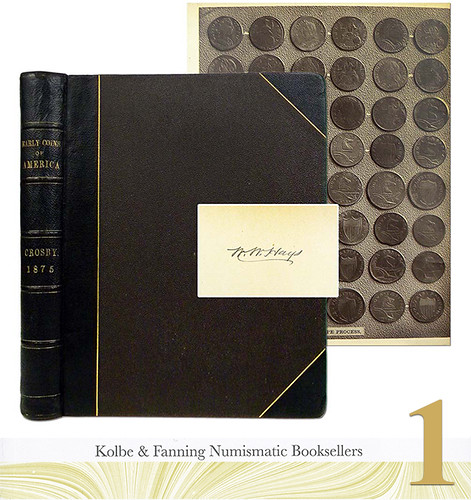
Few would argue about the importance of Sylvester S. Crosby’s The Early Coins of America. It was a landmark work and remains quintessential reading for the American numismatist. Hayes, whose copy this was, was a well-qualified numismatist in his own right. In 1893, he co-authored a monograph on early U.S. coppers with nineteenth century bombast Édouard Frossard.
This example features 110 wood engravings in the text; 2 folding heliotype manuscript facsimiles; 10 fine heliotype plates of coins and tokens with original tissue guards; Woodburytype plate of Dr. Maris mounted on card stock and tipped in between pages 232 and 283. Asking $3,250.
Very Rare First Edition of Breck on Continental Paper Money
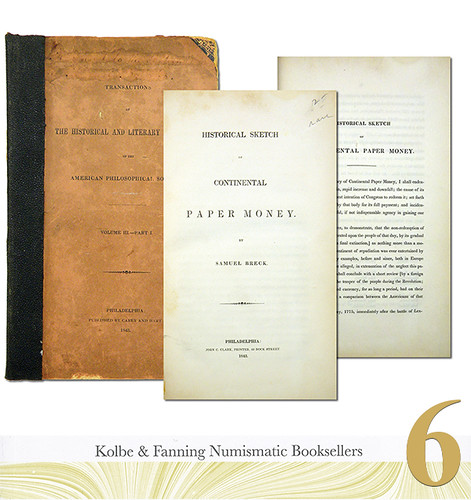
Kolbe & Fanning count this as only the fourth copy that they have ever handled of this landmark early work on Continental paper money. Published in 1843 by the American Philosophical Society, Samuel Breck’s Historical Sketch of Continental Paper Money is one of the most significant early works of American numismatic literature.
This volume also includes Job R. Tyson’s The Social and Intellectual State of the Colony of Pennsylvania prior to the Year 1743, Henry D. Gilpin’s Biographical Notice of Edward Livingston, and Benjamin H. Coates’s On the Effects of Secluded and Gloomy Imprisonment on Individuals of the African Variety of Mankind in the Production of Disease. Priced at $1,000.
The Extremely Rare George Mikhailovich Plates of 1711-1719
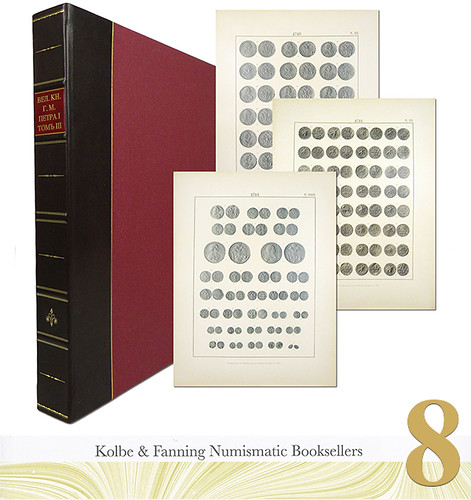
Grand Duke George Mikhailovich (Георгий Михайлович to you Russian speakers), first cousin of Emperor Alexander III, was a general in the Russian Army during World War I and a coin collector of the first order. He met a bitter end at the hands of the Bolsheviks in 1919.
This copy of Coins of Russian Emperors: Peter I, Vol. 3 (МОНЕТЫ ЦАРСТВОВАНIЯ ИМПЕРАТОРА ПЕТРА I. ТОМЪ III) is recently bound in an antiqued quarter morocco clamshell box with burgundy cloth sides. The production of this troubled multi-volume work was affected by the growing turmoil within Imperial Russia. However, it remains an unequalled and crucial reference work in Russian Numismatics. This volume is one of only three examples to come to market that include the 40 prototype plates mentioned above. Ex: Peter Landry. In the original Russian with some French. $12,500 takes it.
A Plated Parmelee Sale
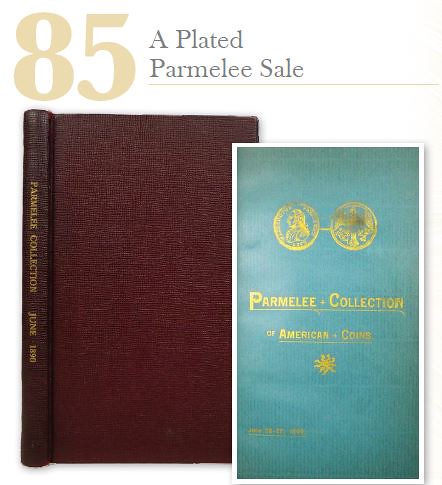
New York Coin & Stamp Co. CATALOGUE OF THE FINEST EXISTING COLLECTION OF AMERICAN COINS, THE PROPERTY OF MR. LORIN G. PARMELEE, OF BOSTON, MASS. New York: Bangs & Co., June 25–27, 1890. 4to, later maroon cloth, gilt; original gilt-printed front wrap bound in. 96 pages; 1443 lots; fine portrait of Parmelee; 13 fine tinted photographic plates. Handpriced throughout in black ink. Fine. $2400
An outstanding sale, rated A+ by Adams: “Absolutely definitive for patterns, colonials (several unique), and regular issue gold, silver and copper.” Parmelee’s remarkable collection has frequently been regarded as the finest collection of American coins ever formed. One hundred copies were issued with plates (though most haven’t survived), attractively tinted to approximate the metal color of the coins depicted. The presentation of the Federal issues is rather unique. Arranged chronologically rather than by denomination, this innovation was not well received at the time, and has seldom been used since. A famous and highly successful Boston bean baker, Parmelee began collecting coins by sorting through the large cents from his daily receipts. He sold duplicates but continually upgraded his personal collection. In his first major coup, he purchased the superb collection formed by George F. Seavey, which was slated to be sold at auction. He acquired the Brevoort collection in 1876, the magnificent Bushnell collection in 1882, and purchased many rarities from Sylvester Crosby. The first two plates illustrate copper patterns and colonials; plates 3 and 4 depict silver patterns and colonials; plate 5 illustrates copper colonials and Washingtonia; plate 6 is mainly devoted to early cents and half cents; plates 7 and 8 largely depict superb early United States silver coins; plates 9 and 10 are devoted to choice cents and half cents; plates 11 and 12 mainly illustrate United States and gold patterns, including a Brasher doubloon; and the final plate is devoted to large denomination nineteenth-century United States silver coins.
To read the complete article, see: 10 Selections from the New Kolbe & Fanning Fixed Price Book You Have to See… (www.coinweek.com/numismatic-history/10-selections-new-kolbe-fanning-fixed-price-book-see/)
To read the complete catalog, see: Select Numismatic Books For Sale at Fixed Prices (www.numislit.com/numislit/images/pdfs/FP2014web.pdf)
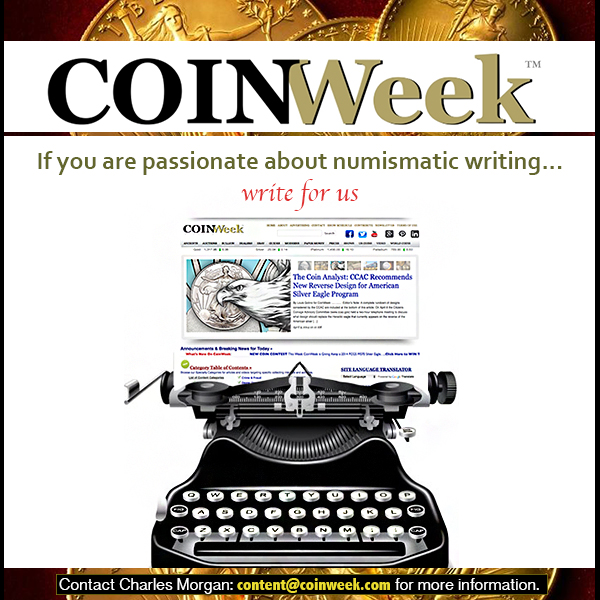
2014 NUMISMATIC LITERARY GUILD AWARD WINNERS
 BOOK OF THE YEAR – The work having the greatest potential impact on numismatics: Whitman Encyclopedia of Obsolete Paper Money, by Q. David Bowers
BOOK OF THE YEAR – The work having the greatest potential impact on numismatics: Whitman Encyclopedia of Obsolete Paper Money, by Q. David Bowers
BEST SPECIALIZED BOOK
United States Coins: New Jersey State Coppers, by Roger S. Siboni, John L. Howes and A. Buell Ish
World Coins: The Island Standard, by John Tully
Tokens and Medals: Utah Trade Tokens, Second Edition, by H. Robert Campbell
U.S. Paper Money: Panic Scrip of 1893, 1907 and 1914, by Neil Shafer and Tom Sheehan
World Paper Money: Standard Catalog of World Paper Money, Specialized Issues, 12th Edition. George S. Cuhaj, Editor
Numismatic Investments: Cash In Your Coins, by Beth Deisher
BEST ARTICLE, SMALL PUBLICATIONS: “Numisgraphics – The Flesh and the Spirit” by John W. Adams, The Asylum
BEST WEB SITE COIN ARTICLE: “The Fabulous Eric Newman Collection” by Greg Reynolds, CoinWeek
BEST WEB SITE TOKEN AND MEDAL ARTICLE: “Spotlight on So-Called Dollars” by Charles Morgan and Hubert Walker, CoinWeek
BEST WEB SITE PAPER MONEY ARTICLE: “The Sochi 100 Ruble Note and Other Circulating Russian Banknotes: A Brief Primer” by Charles Morgan and Hubert Walker, CoinWeek
BEST WEB SITE COLUMN: “USA Coin Album,” David W. Lange, NGC News
BEST ONLINE NEWS WEB SITE: CoinWeek.com, David Lisot, Executive Producer; Scott Purvis, Webmaster
BEST AUCTION CATALOG, COINS AND CURRENCY: “Missouri Cabinet Collection,” January 2014, Ira and Larry Goldberg
Extraordinary Merit: “Selections From the Eric P. Newman Collections, Part II, ” November 2013, Heritage Auctions
BEST AUCTION CATALOG, BOOKS AND EXONUMIA: “John J. Ford, Jr. Collection, Part XXIV, ” September 2013, Stack’s Bowers Galleries
JAMES L. MILLER MEMORIAL AWARD: David W. Lange, The Numismatist, “The Search for A.W. Faxon”
Watch the NLG web site for the complete list of 2014 winners: www.nlgonline.org
OROSZ REVIEWS LUPIA'S NUMISMATIC BIBLIOGRAPHY
 Every 100 years or so, a numismatic bibliography brilliantly illuminates the history of our hobby.
Every 100 years or so, a numismatic bibliography brilliantly illuminates the history of our hobby.
In 1876, it was Emmanuel J. Attinelli’s Numisgraphics, which listed every numismatic auction catalog, book, and price list published in the United States from Colonial times through 1875.
In 2013, it was John N. Lupia III’s American Numismatic Auctions to 1875, Volume 1.
Lupia revises Numisgraphics, adding dozens of publications that Attinelli missed. A comparison of earliest noted auction catalogs will demonstrate what remarkable research Attinelli did for his time, and what a bravura feat Lupia has accomplished in tracing the history of American numismatics back to undreamed-of early days.
In Numisgraphics, Attinelli shared the earliest auction containing coins or medals he could find: the broadside (poster) sale of the collection of Benjamin H. Watkins, of Salem, Mass., in 1828.
I subsequently uncovered two earlier sales: the 1785 broadside selling the collections of Pierre Eugene Du Simitiere — which included one lot of coins and another of paper money — and its resale intact in 1800.
Lupia pushes back the date of the first catalog including numismatic items to the 1758 William Proctor sale of Prussian medals in New York City.
Another of Attinelli’s findings — the first auction in which coins were the main event (as opposed to sales like Watkins or Proctor where coins were part of a larger auction of household items) — was the 1851 sale of the collection Dr. Lewis Roper of Philadelphia.
From 1876 to 2012, no one was able to find an earlier one, but Lupia has, and it is historically significant. The new “pioneer” is the 1813 sale, in Philadelphia, of Phillip Price Jr.’s numismatic collection. Amazingly, within Price’s cabinet was the Du Simitiere collection, still intact 28 years after first going under the hammer.
To read the complete article, see: John N. Lupia's numismatic bibliography illuminates the history of the coin hobb (www.coinworld.com/insights/Latest-numismatic-bibliography-just-published-in-2013.all.html)
To read earlier E-Sylum articles (with ordering information), see:
NEW BOOK: AMERICAN NUMISMATIC AUCTIONS TO 1875
(www.coinbooks.org/esylum_v16n30a04.html)
BOOK REVIEW: AMERICAN NUMISMATIC AUCTIONS TO 1875
(www.coinbooks.org/esylum_v17n10a06.html)
NEW ORLEANS BANKNOTES RECYCLED IN RESPONSE TO THEFT
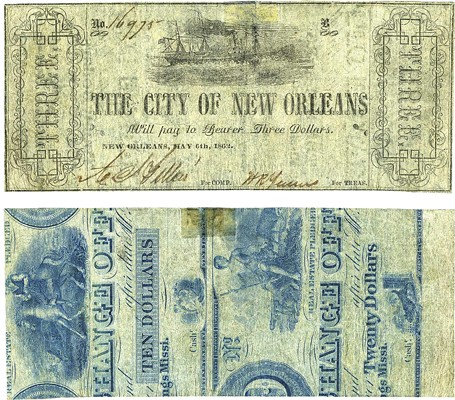
Most collectors of obsolete paper money are quite familiar with notes that were printed on the backs of unused or surplus uncut sheets of paper money. The sources of these sheets were usually banks that had failed or closed.
This practice was particularly prevalent in the South during the Civil War where the Union naval blockade created all sorts of raw material shortages, including bank note paper. The uncut sheets of noncurrent notes could be bought for their scrap paper value and were better than the alternative — not having any paper to use at all.
As a result, many Southern notes (along with a few from the North) are available printed on this “recycled” paper, with portions of the old note designs appearing on the backs of the newly printed bank notes.
But paper shortages were not the only reasons for doing this. Take, for example, the City of New Orleans in May 1862. The city had just undertaken an issue of notes with which it planned to redeem the scrip issued by hundreds of merchants in the city after coins had disappeared from circulation (this was a common problem in both the North and South by 1862).
Just as the program was beginning, the printer reported that hundreds of sheets of unissued notes had been stolen from his office. The city was now faced with the dilemma of how to quickly replace these stolen notes with something distinctive that would essentially make the stolen notes impossible to put into circulation.
Since the stolen notes had no back designs, the authorities came up with an ingenious solution. They purchased sheets of noncurrent Holley Springs, Miss., notes printed in a bright blue hue and directed the printer to print replacement notes of the original design on the backs of these sheets.
As a result, new notes were quickly put into circulation with a difficult-to-replicate blue back design. Even if the thieves could obtain similar Mississippi sheets, they could not easily reproduce the original face design.
To read the complete article, see: Theft of New Orleans obsolete notes in 1862 defeated by clever city officials (www.coinworld.com/insights/Theft-of-New-Orleans-obsolete-notes-in-1862-defeated-by-city-officials.html)
THE BOOK BAZARRE
MORE ON COL. ROBERT C.H. BROCK
Bob Leonard writes:
In response to Ron Guth's query, I researched Robert C. H. Brock in 2001-02 when I was working on the second edition of Breen-Gillio's California Pioneer Fractional Gold (Bowers and Merena Galleries, 2003), because he was one of the few owners of BG-220, the Defiant Eagle 25 Cents (see p. 58). I concluded that he donated his collection in the 1890s or early 1900s; I was not able to learn anything more from the University of Pennsylvania, but Ron might give that another try.
Brock also donated a fabulous collection of Fatimid gold coins, published by George C. Miles as ANSNNM No. 121, 1951. Brock purchased this collection en bloc from Yacoub Artin Pasha, but Miles does not say when. A Google search produces several references to this person, an Egyptian official from the 1880s to the early 1900s, but I found no notice as to when the Fatimid collection was sold. (The collection, long on loan to the ANS, was withdrawn by the University of Pennsylvania when the ANS relocated a few years ago.)
To read the earlier E-Sylum article, see: QUERY: COL. ROBERT C.H. BROCK AND ASSOCIATES (www.coinbooks.org/esylum_v17n32a18.html)
NOTES FROM E-SYLUM READERS: AUGUST 10, 2014
A Silver-Plated 1977 Two Pence
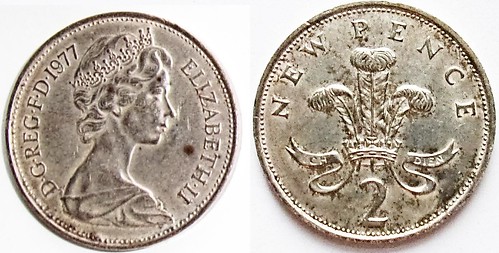
Philip Mernick writes:
Following up your item in the last E-Sylum, I have had this “silver” 2 pence coin since 1977, but I doubt if it worth anything like £1,357. The clue is in the coin’s date 1977, the year Queen Elizabeth II celebrated the silver jubilee of her reign. It is, in fact, silver plated and was given as a gift by a sales rep visiting my father. I have the feeling that I still have the compliments slip somewhere but laying my hands on it might prove difficult!
To read the earlier E-Sylum article, see: AN OFF-METAL ERROR TWO PENCE COIN (www.coinbooks.org/esylum_v17n32a14.html)
More on J.S.G. Boggs Kavan Ratnatunga writes:
I remember meeting this Pittsburgh artist when he visited Carnegie-Mellon University in 2003 October. In addition to an autographed copy of his book, I have my own Boggs Bill. After his talk, he offered to sign one of his bills printed from his website which were oversize and orange. I caught him by surprise when I went up with a correct size and color print of one of his older 10$ notes I had found online. He still signed it on the back.
I also found a recently uploaded 60 min Documentary which was probably made in 1992.
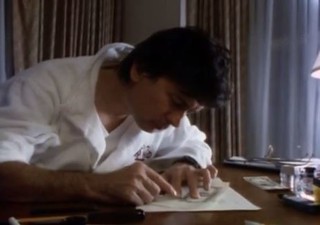 To watch the Money Man video, see:
JSG Boggs in 1992
(www.youtube.com/watch?v=ao4VTw13jsY)
To watch the Money Man video, see:
JSG Boggs in 1992
(www.youtube.com/watch?v=ao4VTw13jsY)
To read the earlier E-Sylum article, see: Renowned artist in the middle of neighborhood dispute over yard filled with garbage (www.abcactionnews.com/news/region-east-hillsborough/brandon/renowned-artist-in-the-middle-of-neighborhood-dispute-over-yard-filled-with-garbage)
To read the earlier E-Sylum article, see: VIDEO OF MONEY ARTIST J.S.G. BOGGS (www.coinbooks.org/esylum_v17n32a26.html)

GOLD KENNEDY PROXY BUYERS LINE UP AT DENVER MINT
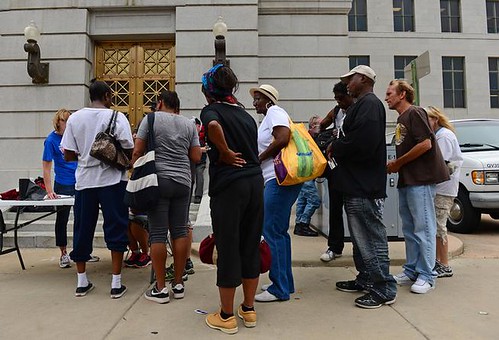
Hundreds of people lined up at dawn Tuesday for a chance to buy one of 500 50th Anniversary Kennedy Half-Dollar Gold Proof Sets at the Denver Mint.
Some were there for the pleasure of owning a coin commemorating the March 1964 release of a silver 50-cent piece bearing the likeness of President John F. Kennedy, who had been assassinated four months earlier.
But many were being paid by coin and bullion dealers trying to get around the one-per-customer rule implemented for the coveted $1,240 coin that contains three-quarters of a troy ounce of .9999 fine, 24-karat gold.
People were lured by cash to the line from as far away as Colorado Springs. Others were promised a chance at a "casting call."
Across from the Mint, workers at a table looked through a list of names, handing out sandwiches and crisp $100 bills to those who successfully purchased coins.
One man said he had been offered $100 for the work but wasn't successful. A woman flashed $400 in her purse as she waited for a cab.
Robert Higgins, co-president of The Argent Group, a Delaware-based bullion company, said his company hired about 100 people from Fort Carson to stand in line and buy coins.
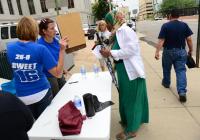 He said people were put up in the Hilton and paid $300 — even the 18 who weren't able to snag a proof set.
He said people were put up in the Hilton and paid $300 — even the 18 who weren't able to snag a proof set.
The company also paid about 150 people from Fort Dix in New Jersey to stand in line at the Philadelphia Mint, he said.
"We've got three more days to go," Higgins said.
U.S. Mint spokesman Mike White said the one-coin limit is intended to make sure the sets are available to as many people as possible, but he said the dealer workarounds are being used in other locations, too.
"Is it right what they are doing? I would say no," White said. "Is it illegal? No, it's not illegal."
In Denver, as a woman who said she represented an East Coast coin dealer handed out preloaded Visa cards to people hired through temporary agencies or recruited "on the street," some who showed up at a 5 a.m. "casting call" for extras were confused to find themselves lined up to buy coins.
Denver photographer Annie Bade showed up thinking she was needed as an extra — and got $200 after purchasing a coin.
"This is people with money using people without money to get more money for the people with money," she said.
However, many of those in line were there for the coin and in memory of Kennedy.
Isabel Vigil, 66, of Lakewood — who was there with her husband, Sam, who celebrated his 69th birthday Tuesday — said she already owns a 1964 silver half dollar.
"I was in high school when he was assassinated," she said. "I felt he was a great president who loved his country."
Mary Greimann, who was there to buy a Kennedy coin because her husband, Hal, is a coin collector and dealer, said the proof set has special significance.
"I think, to a lot of people who grew up during the Kennedy years, it is a special coin," she said.
To read the complete article, see: Proxy buyers clog long line at Denver Mint sale of $1,240 Kennedy coin (www.denverpost.com/business/ci_26278636/line-long-at-u-s-mint-denver-sale)
CROWD TRAMPLED AT DENVER MINT GOLD KENNEDY LINE
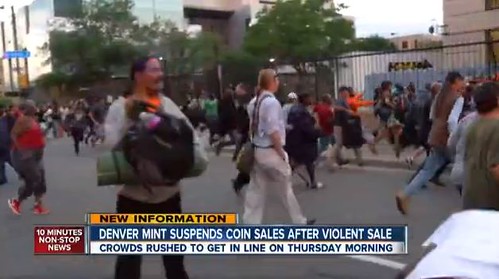
The U.S. Mint said it is suspending sales of its 2014 50th Anniversary Kennedy Half-Dollar Gold Proof Coin at its retail locations to ensure the safety of those wanting to purchase the coin and the safety of their own employees.
This after 7NEWS caught people on video being pushed and trampled as hundreds rushed to get in line at the U.S. Mint in Denver at 6 a.m. Thursday.
The Mint also suspended sales of the coin at its retail locations in Washington, D.C. and Philadelphia as it looks into ways to improve the situation for the next sale.
7NEWS confirmed that several people in line Thursday were being paid by casting directors and coin buyers to be there.
Jennifer DeBroekert, a public affairs specialist with the Denver Mint, said they had no idea that was happening and "don't condone the actions of the coin dealers, or whoever it was, to get people to stand in line."
"It was unethical, but not illegal," DeBroekert added.
To read the complete article, see: Mint suspends sale of JFK gold coin at retail centers after crowd trampled in Denver morning rush (www.thedenverchannel.com/news/local-news/mint-suspends-sale-of-jfk-gold-coin-at-retail-centers-after-crowd-trampled-in-denver-morning-rush08082014)
FIRST GOLD KENNEDY HALF DOLLAR RESOLD FOR $100,000
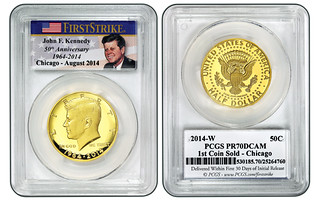 The first Kennedy gold half dollar sold in person to a collector Aug. 5 by the U.S. Mint at the American Numismatic Association World's Fair of Money was resold by two dealers to another collector for $100,000.
The first Kennedy gold half dollar sold in person to a collector Aug. 5 by the U.S. Mint at the American Numismatic Association World's Fair of Money was resold by two dealers to another collector for $100,000.
The coin that Los Angeles collector Nick Yadgarov purchased from the Mint for $1,240 was sold Aug. 7 by David Hendrickson from SilverTowne and California dealer Kevin Lipton to an unnamed collector. Hendrickson and Lipton had purchased the coin from Yadgarov for $5,000, plus Yadgarov received another gold Proof 1964–2014-W Kennedy half dollar from the two dealers.
The $100,000 coin is certified Proof 70 Deep Cameo by Professional Coin Grading Service. PCGS identified the coin on the grading label as the first Proof gold Kennedy half dollar sold by the Mint at the ANA show.
"It's an important coin," Hendrickson said in defending the $100,000 price the Yadgarov coin garnered. "It's the first coin sold — the first coin released of the Kennedy gold coins. There could never be more than one being the first."
To read the complete article, see: First gold Kennedy half dollar sold at ANA convention resold for $100,000 (www.coinworld.com/news/first-gold-kennedy-half-dollar-sold-at-ana-show-resells-for-100000.html)
BUYERS OF FIRST FOUR GOLD KENNEDYS SELL FOR $20,000
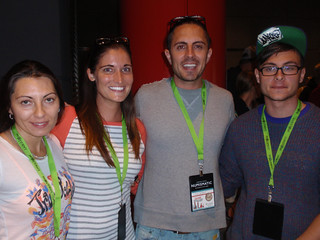 If you could earn $20,000 by waiting all night outside the convention center hosting the American Numismatic Association’s World Fair of Money in Rosemont, Ill., you would probably do it.
That’s the value of being first in line to buy the proof gold Kennedy half dollars that the Mint was to put on sale at the show at 11 a.m. central time.
If you could earn $20,000 by waiting all night outside the convention center hosting the American Numismatic Association’s World Fair of Money in Rosemont, Ill., you would probably do it.
That’s the value of being first in line to buy the proof gold Kennedy half dollars that the Mint was to put on sale at the show at 11 a.m. central time.
Waiting in line was simply the first step of a gauntlet of requirements, but it was something that Nick Yadgarov, a coin collector from Los Angeles willingly did. He was accompanied by his girlfriend, Callie Hohlfeld, his sister Rina Maya and his brother Daniel Yadgarov.
The four showed up at the main entrance of the Donald E. Stephens Convention Center at 11 p.m. Aug. 4, the night before the coins were to go on sale. They obtained the coveted first four places in a line that ultimately stretched a couple of blocks down River Road. That was the first step to obtain the gold coins.
To read the complete article, see: First four gold Kennedys go for $20,000 (www.numismaticnews.net/article/news/general/first-four-gold-kennedys-go-for-20000)
THE BOOK BAZARRE
THE AMMENITIES OF COIN COLLECTORS
One of a Three Part Series:
(Translation of the Chapter added to the Third Edition of Comm. Francesco Gnecchi’s Monete Romane)
(From Spink & Son’s Numismatic Circular)
(From Mehl’s Numismatic Monthly Vol. 1 No. 1 January 1908)
One of my favorite purchases in the recent Kolbe-Craig Smith Library Sale was a complete set of Max Mehl’s Numismatic Monthlies. In the inaugural issue, Mr. Mehl reproduced a three part 19th Century article on the Amenities (or rules of etiquette) of Coin Collectors. What I found particularly interesting was how the principles of “good behavior” in our small part of the collecting world seem to have remained the same for over a century.
I.- BUYING, SELLING AND EXCHANGING.
As the man of society, the artist, the officer, the professional man, and the man of science must observe certain rules in dealing with their colleagues, so must the coin collector if he wishes to be regarded as a gentleman. The special courtesies of the collector can be reduced to a few precepts, but it is well to set them forth in this elementary pamphlet in order that the novice may avoid falling unawares into some lapse of good manners, which might do him harm and result in a serious hindrance to his career as a collector.
Some collectors are at the same time dealers. They collect on their own account, but if they find it advantageous they sell. It must, however, be admitted that the true collector also, he who yields to no one a single piece of his collection, must of necessity become a trader on giving up a duplicate when he has found a better example, and to free himself from a quantity of duplicates on being possessed of a collection. The true collector ought to sell or exchange only with his equals-equal that is, in experience and knowledge of coins.
When the two collectors both know equally well the value of the objects bought or exchanged, there is no more danger of one believing, rightly or wrongly, that he is fighting with unequal weapons, but this danger exists and may be a source of unpleasantness in the contrary case hence it is to be strongly recommended to the experienced collector not to have business relations with the new collectors, but to leave them gain experience with the dealers. For however honest and upright his action may be it will never be held to be so by the novice, not being able to judge from his own knowledge, will always fear he has been over-reached.
II.-RELATIONS WITH COLLECTORS.-VISITS TO COLLECTORS
The collector with few rare exceptions in the case of an egotist or a misanthrope who desires to keep himself shut mysteriously in his own domain, is always pleased when a colleague interests himself in his collection and asks permission to see it.
It is always permissible to ask a collector such a favor, and generally is foolish to refuse it without reason.
When permitted to see a certain collection the visitor must be contented with what the collector chooses to show him, and must not be indiscreet in his demands and above all allow the owner himself to open the cases containing the coins. He should not touch the coins without asking leave, and it should be done with the greatest care, without letting them fall or injuring them in any way. If at any time during the visit the owner is obliged to absent himself for a time leaving the coin cabinet open, the visitor ought not to remain within reach of the coins. Let him withdraw to some distance until the owner returns.
Some years ago and old and respectable dealer who was visiting me for the first time, and in whom I had every confidence was looking at my collection when I was called away by a member of my family.
Without any thought of him I left the room, but saw that the old man followed me into the adjoining room saying: “I will wait here.” And as I was surprised at his doing so, I requested him to continue his inspection. “It is impossible,” said he, “I never remain alone in a room where a coin cabinet is open. If ever it should happen that some coin was missing I should not like to see myself in a position to be suspected.” And I think he was right.
KÜNKER MOVED TO NEW QUARTERS
Since May 2014 Künker has been located in new premises at Nobbenburger Straße 4a. Now, the complete staff is concentrated in one single building. For our clients, nothing has changed besides the address: Nobbenburger Straße 4a is quite close to the old headquarters. And the auction sales will remain at the Steigenberger Hotel Remarque.
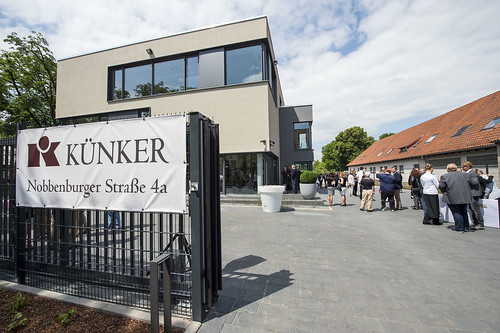
Lack of space forces relocation
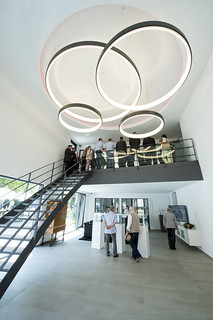 For years, space had grown ever more scarce at the House of Künker. The old premises did not have enough desk space for all 40 employees. The rooms were divided between two houses, and in the case of the library, three. For that reason the management of the House of Künker decided it was time to move: but not to just any space. The new space was to be perfectly tailored to the needs of a coin dealership with an auction business. Therefore, a newly-constructed building was planned. In August of 2012 a suitable property was acquired. The groundbreaking took place in June of 2013. The move followed in May of 2014.
For years, space had grown ever more scarce at the House of Künker. The old premises did not have enough desk space for all 40 employees. The rooms were divided between two houses, and in the case of the library, three. For that reason the management of the House of Künker decided it was time to move: but not to just any space. The new space was to be perfectly tailored to the needs of a coin dealership with an auction business. Therefore, a newly-constructed building was planned. In August of 2012 a suitable property was acquired. The groundbreaking took place in June of 2013. The move followed in May of 2014.
Offices for 40 Employees
Friendly, open spaces with outside visibility and beautiful furnishings now characterize the company’s public image. Numismatists are, above all, happy about the fact that the library has finally been reorganized, and is easily reached. 800 linear meters of shelf space provide a great deal of room for new publications!
The heart of the house is the giant, passable safe with 60 cubic meters of interior space, boasting the most up-to-date security technology.
A Spacious Customer Area
Security is a big issue today. And that’s the reason why the office space is strictly separated from the customer area. Approximately one-third of the house is reserved for customers. Those who wish may enter the premises directly from the company’s own underground parking garage.
The customer area is divided into three sections on three floors. For day-to-day business a spacious reception room is available. Those who have other matters to discuss are directed to the “oval office“, a well-lit meeting room which owes its nickname to its big oval table. Those who want to view coins from the coming auction must come up to the third floor, where the large gallery offers the best daylight conditions.
The new location has changed nothing in the Künker philosophy: The clients’ interests come first.
To visit the Künker web site, see: www.kuenker.de
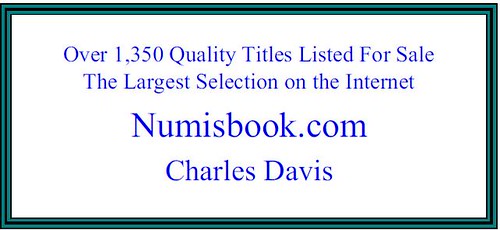
ARTICLE FEATURES CANADIAN WHITE-TAILED DEER COIN ARTIST
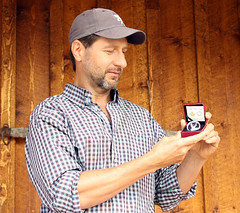 A white-tailed deer drawing by local wildlife artist Desmond McCaffrey is being featured on a new Canadian coin.
A white-tailed deer drawing by local wildlife artist Desmond McCaffrey is being featured on a new Canadian coin.
The $20 face-value collector coin, created by the Royal Canadian Mint, launched on Aug. 5. It is the first of four coins with white-tailed deer drawings being released between August and November.
“It’s so in my wheelhouse to put it bluntly,” said McCaffrey, whose studio featuring his Western Canadian wildlife paintings is located just east of Clairmont Lake. “It’s one of the subjects I love to do along with elk, bear, moose and just animals we have in this area. To have it sort of immortalized on a coin like that was really an honour.”
McCaffrey also designed a second coin for the white-tailed deer series. He said the Royal Canadian Mint contacted him about a year ago to submit two pieces.
“I assume they had seen some of my work on my website and some of the other animals I had done,” said McCaffrey. “And they liked the way the animals were drawn and rendered and just the actual size of them in proportion to the backgrounds.”
The Royal Canadian Mint let him know they were looking at other artists around the country and the competition was stiff. But approximately four weeks later, McCaffrey got the call that they had selected both of his drawings.
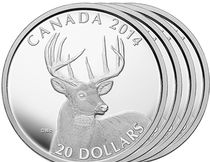 Submitting the pencil drawings took about a month as McCaffrey made some changes to the background and went back and forth with the designers at the mint. White-tailed deer experts and biologists looked at the drawing to make sure the anatomy was correct. After, the coins were signed off by the Finance Minister then engraved at the mint.
Submitting the pencil drawings took about a month as McCaffrey made some changes to the background and went back and forth with the designers at the mint. White-tailed deer experts and biologists looked at the drawing to make sure the anatomy was correct. After, the coins were signed off by the Finance Minister then engraved at the mint.
McCaffrey is being paid for his work.
“There was a financial part to it for sure. It was really good and I’m very happy with that end of it but it was more to me just going through the process and having been selected even was more than that to me,” said McCaffrey.
While designing a coin for the Royal Canadian Mint is a new experience, drawing animals is not. McCaffrey has been a full-time wildlife artist for 25 years but his love for drawing animals started as a kid.
To read the complete article, see: Work of local artist featured on new silver coin (www.dailyheraldtribune.com/2014/08/07/work-of-local-artist-featured-on-new-silver-coin)
THE GROWTH OF NON-CIRCULATING LEGAL TENDER COINAGE
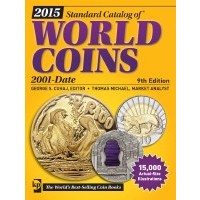 A few days ago I go my copy of the Krause 2015 Standard Catalog of World Coins 21st Century. It was the first time I had a copy and I was surprised it was so big in just 13 years.. I did an OCR of the contents page and computed a more complete ordered list of the rough page count. It is clear what countries are trying to profit from non-circulating legal tender (NCLT). I would not have guessed that Australia and Canada would head the list.
A few days ago I go my copy of the Krause 2015 Standard Catalog of World Coins 21st Century. It was the first time I had a copy and I was surprised it was so big in just 13 years.. I did an OCR of the contents page and computed a more complete ordered list of the rough page count. It is clear what countries are trying to profit from non-circulating legal tender (NCLT). I would not have guessed that Australia and Canada would head the list.
I am so glad that Sri Lanka averages only just over 1 NCLT per year. i.e 27 coins in the 25 years since 1990.
Before this NCLT business for profits kills the nature of numismatics, SCWC should separate the NCLT into its own volume which those interested in Numismatics can ignore. Else KP will not get even 25 years into the 21st century volume before it becomes too big to handle.
Pages in SCWC 21st century for each country..
84 Australia
69 Canada
50 Niue
46 Cook Islands
42 Russia
34 North Korea
32 France
30 Poland
27 Isle of Man
26 Ukraine
26 China - Peoples Republic
25 Palau
23 United States of America
23 Great Britain
22 Belarus
21 Spain
20 Mexico
14 South Africa
13 Liberia
13 Kazakhstan
13 Gibraltar
13 Germany
13 Fiji
12 Austria
11 Turkey
11 Congo Democratic Republic
11 British Virgin Islands
10 New Zealand
10 Israel
9 Netherlands
9 Falkland Islands
9 Cuba
8 Somalia
8 Solomon Islands
8 Portugal
8 Mongolia
8 India
8 Hungary
8 Finland
8 Czech Republic
8 Andorra
8 Alderney
The complete list is posted at http://coins.lakdiva.org/scwc/country.out
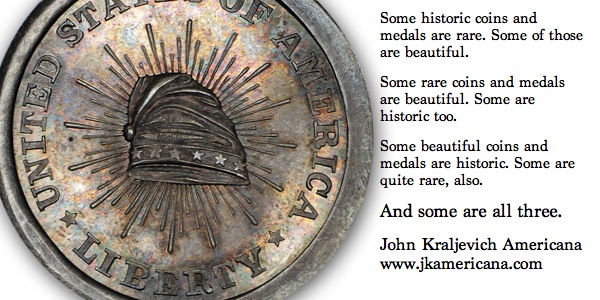
WAYNE'S NUMISMATIC DIARY: AUGUST 10, 2014
THURSDAY
Thursday morning brought a new experience for me - flying out of Reagan National airport to Chicago for the ANA convention. I live near the Dulles airport, but this time I was taking American out of Reagan. I left my house extra early to allow for problems. I passed the silent Pentagon and managed to snag a decent parking spot in the economy lot. My flight to O'Hare airport and shuttle to the hotel were uneventful.
Chopmarks
I checked into my room at the Hyatt Regency and made a beeline for the show. The beeline was an indirect path though, meandering a couple blocks thru the long walkway to the convention center. My initial destination was the Money Talks room.
I got there a little too late to meet and introduce myself to Colin Guilberg, who was already giving a talk on Chopmarked coins to a large audience. I spotted Susan McMillan, Charles Morgan of CoinWeek and Howard Daniel, but didn't get a chance to talk.
The NBS Symposium
My next stop was the Numismatic Bibliomania Society Symposium. Before it started I chatted with a number of folks, including David Sundman, Myron and Darryl Xenos, Joel Orosz, Len Augsburger, Pete Smith, Paul Hybert, Ralph Winter, George Kolbe and others.
From Marc and Charles Ricard I learned that Krause Publications had cancelled the decades-long Numismatic Ambassador program, of which I'm a previous inductee. It's an unfortunate decision. I'd spent many an hour pondering candidate bios to prepare my ballot each year, selecting those I felt best exemplified the selfless dedication to hobby service that the award honors.
I also learned about the big controversy of the convention - the long lines of people camped out for hours to buy gold Kennedy half dollars from the U.S. Mint. Dealers had hired a carnival of line-sitters, bussing them in from points distant to purchase gold Kennedy half dollars from the U.S. Mint. To hear people tell it, it was an invasion of unwashed vagrants, trailer trash and Chinamen, which frightened the general populace. What a disaster, all around. Midweek the Mint cancelled in-person sales.
Dave Bowers and Dennis Tucker gave a great presentation on the steps and thought processes involved in becoming a numismatic author. Ken Bressett walked in a bit late and was recognized by Dave and the crowd. In the Q&A session I asked Dave about the current library market, wondering if budget cutbacks and electronic publication have affected purchases of new numismatic books by libraries. Dennis summarized the marking in one word: DEAD. I'd been afraid of that. It's a shame that the high-quality numismatic publications being produced today aren't finding their way into our public libraries.
On to the Bourse
After the symposium I headed for the bourse floor. Among the folks I visited with were Phillip Mussel of Token Publishing, and Ed Reiter (seated at the COINage table. At Charlie Davis' tables I spoke with Jim Neiswinter, Neil Musante, and of course, Charlie. We talked a bit about the John Burns estate. Phil Mussell had also mentioned John. He said he was a good friend, and when he said "... and John came over, profusely sweating...", I knew that he indeed knew John well.
Medal Collectors of America
My next stop was the meeting of the Medal Collectors of America (MCA). Attendees included Simcha Kuritsky, John Adams, Anne Bentley, Joel Orosz, Tony Lopez, Skyler Liechty, Bill Swoger, Roger Siboni and Pete Smith. I was very happy to meet Anne, Skyler and Tony for the first time, having been email pen pals for some time.
The first speaker was Len Augsburger, with a nice presentation on the medals and other engraving work of Christian Gobrecht. Here are a couple nice images Len shared with me.
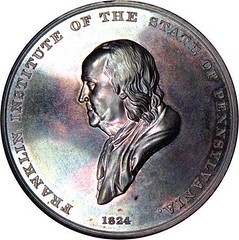
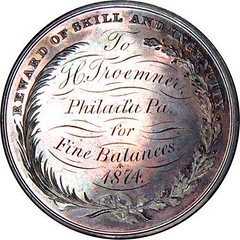
Franklin Institute medal
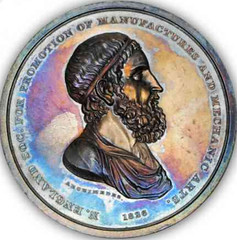

New England Society For Promotion of Manufactures And Mechanic Arts medal
Next up was art historian Tom Garver, who presented an excellent paper on "The French Narrative Medal". I hope to have more about his presentation in a future issue.
Dinner with the Biblio-Gang
For dinner I'd been invited to join a group of numismatic bibliophiles. Dan Hamelberg would meet us at the restaurant, McCormick & Schmick. The rest of us gathered in the expo center lobby and walked over. The group was comprised of George Kolbe, myself, Charlie Davis, Joel Orosz, David Fanning, his wife Maria and their son Sam.
It was a long and enjoyable evening, starting with some appetizers, going into the main course, and followed by desserts and more conversation. I complimented Maria on her great graphic design work on the Kolbe-Fanning catalogs and fixed price lists, and she filled me in on some of the exhibits at the show. Other topics included John Burns, Remy Bourne, Chris Komody, Eric Newman, and shipping books and art from Europe. Dan drove us all back to the Hyatt. It was a great way to end a long day.
FRIDAY
Breakfast with Dave
At 7am I met NBS Treasurer David Sundman for a nice breakfast. We reviewed some updates for the NBS web site, and discussed some financial arrangements on advertisements for the web site. Afterwards I went back to my room and put the finishing touches on my presentation for the NBS meeting later that morning. It all came together quickly. While part of me wanted to work on The E-Sylum, I was glad to flesh out my talk on The Past, Present and Future of Online Numismatics. It sure was a trip down memory lane.
A Special Lunch
Knowing I'd have a long day and would be busy around lunchtime (and having heard from David Fanning how the bourse canteen had run out of all food by 2pm Thursday), I decided to have an early lunch. I was still on east coast time anyway, and was used to getting up early.
Along the walkway I was stopped by Tom Harrison, an NBS member and E-Sylum subscriber. He showed me Armand Champa's copy of the "Invasion of Pittsburgh" book I'd put together, a collection of photos of a visit to the Carnegie Library of Pittsburgh rare book room in 1989, I believe.
When I walked into the Expoteria, it seemed empty save one lonely cashier. When I asked, she confirmed that they were indeed open. When I ordered a burger, the cook told me they were only serving breakfast. But he agreed to make me one if I'd wait, and accept hash browns instead of fries. Sounded good to me.
The manager came out of the kitchen and I thought he'd raise a fuss. But he said, "hey, you must be one of those guys still on East Coast time, already looking for lunch." I was in love. He SO gets me. So I got my burger, and (shhh, please don’t tell anyone - the cashier threw in a candy bar free). All in all, it was my kind of reward for being first in line. Who knew cafeteria people weren't all sourpusses?
NBS Meeting
I showed up early to set up the projector for my presentation at the NBS General Meeting. It was a good crowd of almost 40 people, many of whom I'd already seen at the convention.
Former American Numismatic Society librarian Elizabeth Hahn Benge was there, and it was great so see her. She's now living in the Chicago area.
After Dan Hamelberg's short presentation on his displayed items, I gave my talk on the Past, Present and Future of Online Numismatics. I had a great time giving it, and it seemed very well received. Several folks stopped to thank me afterwards.
To the Bourse, of Course
After the NBS meeting I headed down to the bourse floor with Dennis Tucker. He bought his lunch and I got a pretzel to snack on. We had a nice talk about my web site project. Joel Orosz and Len Augsburger joined the conversation after a while. John Mutch and Gene Hessler stopped by at different times as well.
Next, Joel Orosz and I decided to saunter around the exhibit area, and were impressed with many of the exhibits we saw. Along the way we ran into John Adams, George Kolbe, Paul Hybert, Pete Smith and others. We both enjoyed David Sundman's great exhibit on his 1870 Carson City die, which he has now paired with a coin struck from the die. Wow!
Other exhibits covered the Two Cent piece, the Susan B. Anthony dollar, Baby Bonds, Signers of U.S. paper money, a complete collection of wooden medals of the 1876 Centennial, the Tenino, WA wooden money scrip, and Operation Bernhard notes.
Some of my favorites included exhibits on the Pedley Ryan dollars of 1933, and one on the obsolete notes of Chattanooga, Tennessee. We met and congratulated the cowboy-hat-wearing exhibitor who happened to pass by.
Somehow I missed the exhibit on Morse Code on coins. We cut our visit short so Joel could go to a Money Talks presentation by Coin World editor Steve Roach. The rest of the afternoon was a blur. I raced around the bourse floor making the most of the time I had left. In short succession I'd spoken with Christopher Webb of Dix Noonan Webb, Julie Lecoindre of Baldwin's, and several others.
I caught up again with Joel at the tail end of Steve's talk, where I also ran into Pat McBride and Walt Ostromecki. I chatted for a bit afterwards with Jeff Starck and Steve, before we went our separate ways. Jeff was on his way to the House of Blues for an event with one of the world mints; Steve and I were going to rest up before the banquet.
I didn't rest long - Len Augsburger called and we met to chat in the lobby. Someone nearby called my name. I had to admit I didn't recognize him. It turned out to be Archie Black, and old friend from my days working at Bell Labs in Holmdel, NJ. We'd bumped into each other somehow and discovered we were both collectors, with Archie's specialty being casino chips and tokens. I was great to see him again and meet his wife.
Banquet
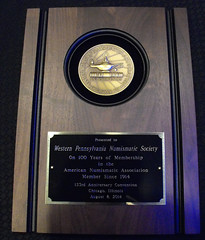 At 7pm I headed back to my room to call my wife and change into a suit for the awards banquet. While I would ordinarily choose a small dinner with friends over any banquet, I wanted to be there for this one to see my hometown coin club be honored. The Western Pennsylvania Numismatic Society (WPNS) was being recognized for 100 years of ANA membership.
At 7pm I headed back to my room to call my wife and change into a suit for the awards banquet. While I would ordinarily choose a small dinner with friends over any banquet, I wanted to be there for this one to see my hometown coin club be honored. The Western Pennsylvania Numismatic Society (WPNS) was being recognized for 100 years of ANA membership.
I was looking forward to the reception, which is a great time to mingle with old friends over drinks. I'd paid the full $95 list price and thought there would be hors d'oeuvres, but alas, there wasn't a cocktail weenie in sight. But I thought the dinner was pretty decent for banquet fare.
Among the folks I chatted with were David Lisot, Clifford Mishler, Ron Guth, Gene Hessler, Bob Leonard, Neil Shafer and Robert Galiette. Rob's collection of Liberty Head $20 Gold pieces had just been sold at auction, and he seemed happy with the results. I signed a copy of the accompanying book he wrote with Dave Bowers.
I also spoke a bit with Numismatist editor Barbara Gregory and learned that the organization is planning to digitize all of the back issues of club's flagship publication, a long-overdue step that will make more accessible to researchers a trove of great numismatic information.
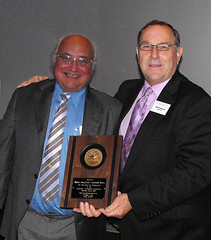 WPNS President Ed Krivoniak was seated at an awardees table up front. I joined the remaining Pittsburgh-area crowd at another table, sitting between Larry Korchnak and Pat McBride. It was fun to see everyone and trade jokes and stories. Many pictures were taken of Ed receiving the plaque from ANA President Walt Ostromecki, and we also took a group photo around our table.
WPNS President Ed Krivoniak was seated at an awardees table up front. I joined the remaining Pittsburgh-area crowd at another table, sitting between Larry Korchnak and Pat McBride. It was fun to see everyone and trade jokes and stories. Many pictures were taken of Ed receiving the plaque from ANA President Walt Ostromecki, and we also took a group photo around our table.
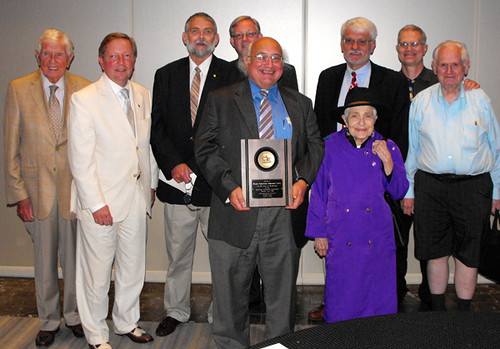 Front - Ed Krivoniak (president), Nancy Shiff
Back - Andy Uram, Tom Uram, Tom Corey, Wayne Homren,
Front - Ed Krivoniak (president), Nancy Shiff
Back - Andy Uram, Tom Uram, Tom Corey, Wayne Homren,
Larry Korchnak, Blaine Shiff, Ted Shiff
Photos courtesy Pat McBride
The ANA's People's Choice award is named for another Pittsburgh-area resident, Rodger Hershey. Many of us had known Rodger and we applauded this year's winner, Charmy Harker. Her exhibit on unusual uses for one-cent coins was nicely done, and we agreed that it was one Rodger would have approved of. She was seated at an adjoining table, so I introduced myself and signed her up for The E-Sylum.
Wendell Wolka did a fine job as MC. I could relate to his comment about the walkway between the convention hotel and convention center "passing thru two time zones." He kept things on track despite one recipient's rambling talk on his 50 years of membership, wherein the audience started clapping (twice!) in hopes that he'd fast-forward to the present and put us out of our misery.
While I'd missed out on attending a restaurant dinner that night with John Kraljevich, John Feigenbaum and others, it was an honor to be there and applaud the achievements of honorees Guth, Hessler, Shafer and others. Another banquet for the record books.
SATURDAY
Rittenhouse Society Breakfast
Saturday morning I made my way across the lobby to the annual breakfast meeting of The Rittenhouse Society. Founded in 1957, the group consists of numismatists interested in numismatic research. Founding members included Q. David Bowers and Ken Bressett, both of whom were present.
The meeting is the one and only time during the year that the group assembles, and I have to pinch myself each time I attend, in awe of the breadth and depth of numismatic knowledge gathered in a single room. I ended up sitting between John Kraljevich and John W. Adams. Also at my table were George Kolbe, Jeff Garrett and Ron Guth. In all some 35 members and several spouses were in attendance.
One by one each member stood and introduced themselves, and spoke about their collecting and research interests, and current projects. Several had new manuscripts in the works. The last order of business is the consideration of new members, and by unanimous vote David Schenkman joined our ranks. As author of several books and a constant researcher and writer on tokens, he's eminently qualified.
Many thanks to Whitman Publishing for sponsoring the gathering. I was able to see a number of great folks I rarely encounter during the year, including Bob Julian, Bob van Ryzin, Bill Bugert, Pete Smith, Mark Borckardt and Wendell Wolka.
Before leaving the room I spoke with Phil Bressett and Joel Orosz about the first printing of The Fantastic 1804 Dollar, the rare versions before the updates about the King of Siam set which burst into view at the 1962 ANA convention.
The rest of Saturday for me was a leisurely walk around the bourse floor, where many of the dealers were either packing up or had already left. I missed seeing John Feigenbaum, Jake Sherlock of the ANA, and others. I did manage to chat with several folks though, including Doug Mudd of the ANA, Brian Kendrella of Stack's, Rob Galiette, Dave Wnuck, Bob Rhue, and Greg Ruby, whose organizational meeting for Sherlockian Numismatists was a success.
I left early and killed some time at the airport, working a bit on The E-Sylum. The flight home was uneventful, and the landing was a delight. The first recognizable structure to come in to view was Lincoln Center, followed quickly by the Lincoln Memorial, Washington Monument and Jefferson Memorial. In the distance was the dome of the U.S. Capitol, gleaming white through the darkness. It would be after midnight before I got home, but it was a super trip all around.
Many thanks to those who stopped to thank me for my work on The E-Sylum. You folks are why I keep doing it every week. It's great to get that feedback and know the effort is appreciated.
THE BOOK BAZARRE
GETTING YOUR NUMISMATIC BOOK IN PRINT
Proposals should include...
- cover letter with name of author(s) and contact information (address, phone, email)
- proposed title of book
- names of any contributors (research assistants, consultants, et al.)
- intended audience of the book (be specific)
- analysis of current competition (similar books on the market, standard references, etc.)
- proposed format (size, page count, binding, illustrations, etc.)
- brief biography of the author(s) and significant contributors
- a detailed table of contents, and at least two sample chapters
Proposals should address...
1. Has your book been published before? If so, please give details (date, publisher, format, print run, quantity sold, who currently owns the copyright).
2. How will your book be superior to others in the same subject field? Discuss the relative strengths and weaknesses of competing texts; show how your book will differ from each (e.g., in topic coverage, approach, features, etc.). If no competing books exist, why is that so?
3. How many copies do you expect would sell in the first 12 months?
4. Production timeline (how long do you need to finish your manuscript (e.g., write text, gather images, compile data)?
5. Has your manuscript been peer reviewed? If not, feel free to recommend several experts qualified to analyze your responses to this proposal. We may also submit your proposal to others, for their review.
The Whitman Publishing Staff
There is a large staff of specialists at Whitman involved in taking a book from manuscript to final published form. The following list is extracted from the Whitman Author Guide.
- The Publisher
- The Acquisitions Editor
- The Production Editor
- The Copyeditor
- The Art Director
- The Designer
- The Typesetter
- The Numismatic Director (Q. David Bowers)
- The Director of Numismatic Research
- The Pricing Analyst
While on some projects people may wear multiple hats, each of these roles is a vital part of the process in creating the quality finished product readers know and expect from a printed book.
Many thanks to Dennis for describing the process. E-Sylum readers are encouraged to put together manuscripts of their research and seek a publisher like Whitman who can make your book a reality. The world can never have enough numismatic books!
For more information about Whitman, see: www.whitman.com
THE VERY FIRST STEAM COINAGE MEDAL

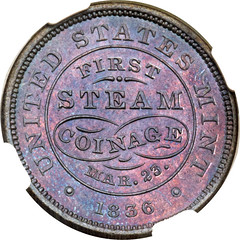
Unlike the original mint building, the second facility at the corner of Chestnut and Juniper Streets in Philadelphia was designed to utilize steam power. The first steam-powered coining press was expected to debut on February 22, 1836, but a mechanical problem delayed the initial operation until March 23. Sample dies were prepared with the February date, with a few impressions struck on screw presses in anticipation of the event. However, the delayed initial operation meant that those dies were overdated, with MAR 23 engraved over FEB 22. Once all was set, the First Steam Coinage medals were struck on large cent planchets.
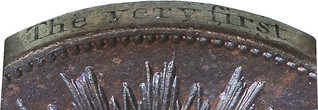 This example is engraved "The Very First" on the edge at 12 o'clock and it was presented to Mint Director Robert Maskell Patterson who oversaw the steam coinage developments. He wrote that day to Treasury Secretary Levi Woodbury: "I also send, by this mail, some copper pieces struck at the mint today on our new press by steam. They are the first ever struck by this power in America. We must consider this day, therefore, as marking an epoch in our coinage."
This example is engraved "The Very First" on the edge at 12 o'clock and it was presented to Mint Director Robert Maskell Patterson who oversaw the steam coinage developments. He wrote that day to Treasury Secretary Levi Woodbury: "I also send, by this mail, some copper pieces struck at the mint today on our new press by steam. They are the first ever struck by this power in America. We must consider this day, therefore, as marking an epoch in our coinage."
It is fitting that this impressive Gem is offered at the auction of the ANA Convention, since the very same press is displayed today at the museum of the American Numismatic Association in Colorado Springs, Colorado.
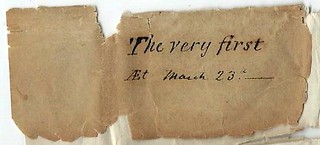
To read the complete auction lot description, see: Lot 5792: 1836 First Steam Coinage, Mar. 23, (coins.ha.com/itm/u.s.-mint-medals/tokens-and-medals/1836-first-steam-coinage-mar-23-original-ms65-brown-ngc-julian-mt-21/a/1208-5792.s)
ELECTRA WAGGONER BIGGS AND MEDALLIC ART COMPANY
Here's a tale you won't believe but is true, and it also proves everything is bigger in Texas.
Dan Waggoner began ranching with a small herd on a modest tract of land in northern Texas beginning in 1849. When he died the ranch became the property of W.T. Waggoner, his son.
W.T Waggoner became wildly successful raising Hertford cattle. With profits from the sale of cattle he bought more land, and more land until he owned more than 510,000 acres, covering most of six counties across the northern Texas border.
Then oil was discovered on Waggoner's ranch. 1,200 oil wells joined hundreds of thousands of cattle, increasing Waggoner's estate, large even by Texas standards. W.T. developed a passion for American quarter horses breeding these on his massive ranch.
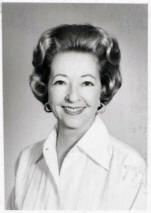 W.T. Waggoner had only one heir -- his daughter, Electra Waggoner Biggs. She did not take an active role in managing the ranch. Instead she became interested in sculpture. As a 20-year-old she travelled to New York City to seek sculpture training.
W.T. Waggoner had only one heir -- his daughter, Electra Waggoner Biggs. She did not take an active role in managing the ranch. Instead she became interested in sculpture. As a 20-year-old she travelled to New York City to seek sculpture training.
The clique of New York sculptors readily accepted the attractive Texan and vied to train her in the craft and art of sculpture. It was here she also met two brothers, Henri and Felix Weil, of Medallic Art Company, recommended to her by her instructors, noted for reproducing any small bas-relief of her creation.
Her father feared she would remain in New York, so he built her a large house in one of the communities his ranch surrounded if she would return to Texas. She did and put her sculpture talent to use. Amon G. Carter commissioned her, in 1935, to prepare an equestrian statue of his friend Will Rogers, astride his horse Soapsuds.
In 1938 she sent a plaster portrait model of a family member to the Weils. She wanted it reduced to charm size and goldplated. So pleased, she sent six more that year and eight more the following year. In all, over the next 26 years, the firm created 87 such miniature works of art of her family, friends and their children for the Texas artist.
While Electra Waggoner Biggs may be one of the most colorful artist clients of Medallic Art, what else do we know about her? She married John Biggs. Electra Texas, in Wichita County, is named after her mother. She has a building named in her honor in her hometown at Vernon College.
But most interesting, perhaps, is that the Buick Electra luxury car was named after her. Her husband's brother-in-law was president of Buick Motors at General Motors at the time. Also a Lockheed airplane is named in her honor.
Electra sought to liquidate the Waggoner estate in 1991, but that spurred a family feud that lasted until this year. She died April 23, 2001 without seeing this resolved.
This Friday, August 8, 2014 a judge finally ruled the estate could be sold. Included: 510,000 acres, 30,000 acres of farmland, 1,200 oil wells, all accompanied by hundreds of homes and 30 cowboy camps.
Price: $725 million.
To read an article on the sale of the estate, see: Waggoner Ranch, among US' largest, listed for sale (www.chron.com/news/us/article/Waggoner-Ranch-among-US-largest-listed-for-sale-5677675.php)
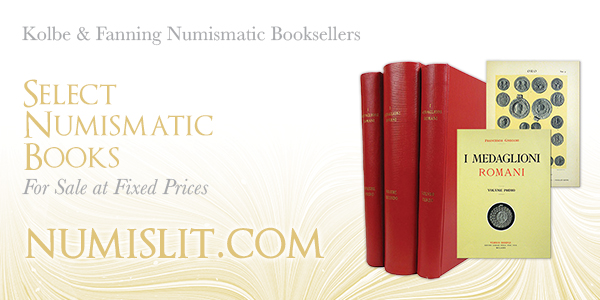
1877 HALF UNION PATTERN IN GILT COPPER
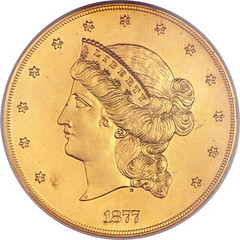
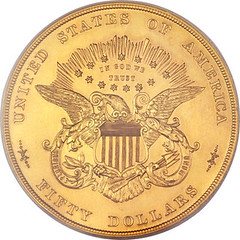
The fifty dollar patterns, named half unions, were struck in both Large and Small Head varieties, both types using a common reverse. One specimen of each design was struck in gold (Judd-1546 and Judd-1548) and a small number of copper examples of each design were also produced (Judd-1547 and Judd-1549). Some of the copper coins, including the present Small Head Judd-1549 specimen, were gilt, but it is not clear if this was done at the Mint or later.
The idea for the $100 union and $50 half union gold coinage originated during the California Gold Rush in the 1850s... Many years later, in 1877, the half union patterns were struck at the Philadelphia Mint during the directorship of Henry Richard Linderman. Linderman was a clerk at the Mint in 1855, and may have remembered the half union proposal from his early days in government service. He had many patterns struck for unofficial reasons during his later terms as Mint Director and formed a spectacular collection of his own, mostly of pattern and restrike issues. The half unions were apparently a "pet project" of Linderman's, according to the editor of the 10th edition of the Judd reference, as there was no pressing need for the large gold coins in 1877.
Impressions from the dies for the half union were reportedly sent to Linderman on August 30, 1877, so the patterns must have been struck in late August. The two gold half unions weigh 1289.1 and 1287.3 grains respectively, in line with the specifications outlined in Gwin's 1854 bill. Mint correspondence of the time indicates that Mint personnel feared such large gold coins would be especially vulnerable to rim filing and being hollowed out and filled by base metal, such as lead. The project was soon abandoned as impractical, and the copper patterns were clandestinely marketed to favored collectors.
Chief Coiner A. Louden Snowden acquired the two gold half unions, which were supposed to be melted, by paying the Mint Director the bullion value and a charge for pattern pieces. He later sold these coins to William Woodin, future Secretary of the Treasury, with coin dealer John W. Haseltine acting as intermediary. A scandal ensued when the transaction was made public and a complicated series of legal maneuvers and under-the-table deals resulted in Woodin returning the half unions in exchange for a treasure trove of other patterns, presumably also acquired by Snowden during his tenure as Chief Coiner, and later Superintendent, at the Philadelphia Mint.
The gold half unions are safely ensconced in the National Numismatic Collection at the Smithsonian Institution today. USPatterns.com suggests fewer than a dozen examples of Judd-1549 survive today, with one specimen in the Smithsonian and another in the Connecticut State Library. About half the known specimens are gilt.
To read the complete article, see: 1877 $50 Fifty Dollar, Judd-1549a Gilt, Pollock-1722 (coins.ha.com/itm/patterns/1877-50-fifty-dollar-judd-1549a-gilt-pollock-1722-low-r7-pr63-pcgs/p/1209-54131.s)
OMSA MEDAL QUIZ ANSWERS
Peter Bertram writes:
Just reading through the last issue of E-Sylum (V17-#32) and noticed your article on the OMSA's "2104" Convention. Jumping the gun a bit, are we? Don't think I'll live long enough to attend that one. Pretty sure you meant 2014 Convention.
Peter Bertram writes:
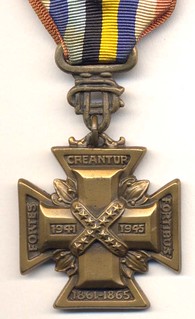 I can't help with the first two but the third one is the UDC (United Daughters of the Confederacy) WWII Cross of Military Service awarded to WWII veterans who were descendants of Confederate soldiers. The motto in the top three arms of the Cross is “Fortes Creantur Fortibus” (The Brave Begat the Brave) and the dates in the bottom arm, 1861-1865, are the dates of the War Between the States. The center cross is to recall the original Southern Cross of Honor, the crossed stars in center represent the Confederate Battle Flag, and the dates 1941-1945 are, of course, for WWII. Note the connector at the bottom of the ribbon is the intertwined letters of the UDC and the colors in the ribbon represent the Allied nations during WWII. For Cross recipients who served overseas during the war, a small bronze dolphin (not shown) was available to pin on the ribbon.
I can't help with the first two but the third one is the UDC (United Daughters of the Confederacy) WWII Cross of Military Service awarded to WWII veterans who were descendants of Confederate soldiers. The motto in the top three arms of the Cross is “Fortes Creantur Fortibus” (The Brave Begat the Brave) and the dates in the bottom arm, 1861-1865, are the dates of the War Between the States. The center cross is to recall the original Southern Cross of Honor, the crossed stars in center represent the Confederate Battle Flag, and the dates 1941-1945 are, of course, for WWII. Note the connector at the bottom of the ribbon is the intertwined letters of the UDC and the colors in the ribbon represent the Allied nations during WWII. For Cross recipients who served overseas during the war, a small bronze dolphin (not shown) was available to pin on the ribbon.
In addition to WWII, the UDC issued similar crosses for WWI, The Korean War, and Vietnam. Slightly different style crosses were presented earlier for the Spanish American War and the Philippine Insurrection.
Rich Hartzog writes:
The quiz on the 3 military type medals was too easy. Right-clicking them brings up Flickr where they are briefly identified. A bit more info on two:
Brazil Rose, Order of the Rose - Knights Breast Badge. Six pointed, gold rimmed, white enamel star, each point gold ball tipped. Star superimposed on gold circular medallion. Center medallion is silver and has the entwined initials "P" and "A" (Pedro and Amelia) surrounded by a silver rimmed band inscribed "AMOR E FIDELIDADE (Love and Fidelity). With an outer band of pink roses and green leaves.
China WW I Victory type 1
USA UDC WW II Cross, more commonly called a Southern Cross of Honor
To read the complete article, see: 2014 ORDERS & MEDALS SOCIETY CONVENTION (www.coinbooks.org/esylum_v17n32a20.html)
WEISS ANCIENT COINS RETURNED TO GREECE
Five ancient coins were returned to the Greek government Monday after a prominent collector from Rhode Island was prosecuted in a New York case that roiled the numismatic world.
Dating as far back as 515 B.C., the silver coins will be displayed for public view and research at the Numismatic Museum of Athens, Manhattan District Attorney Cyrus R. Vance Jr. and Greek announced at a ceremony marking the repatriation of coins dating to 500 B.C.
"The coins being returned to us by the New York County district attorney are exquisite ancient artifacts that reflect Greece's culture, history and enduring strength," said Ambassador Christos Panagopoulos. "Back home, where they belong, they will be displayed — with the gratitude of the Greek people to the DA — for all to admire, our citizens and visitors to Greece alike."
The pieces include two types of ancient Greek currency — staters and a didracham, or two-drachma coin — bearing images that include gods and other mythological figures.
They "will be of greater public benefit in an open place of study and scholarship than locked away in a safe," Vance said.
The coins were part of a case against hand surgeon and coin aficionado Dr. Arnold-Peter Weiss, whose January 2012 arrest during a coin auction at the Waldorf-Astoria hotel.
An orthopedics professor at Brown University's Alpert Medical School and author of a hand-surgery textbook, Weiss also had been on a coin collector and investor for 35 years and had served as on the board of the American Numismatic Society.
He later pleaded guilty to attempted criminal possession of stolen property. Those charges involved three coins he thought were fourth century B.C. Greek pieces that had been illegally taken from Italy — but were actually forgeries, prosecutors said. Weiss was aiming to sell one of them for about $350,000 and two others for about $1.2 million apiece, prosecutors said.
As part of his plea agreement, Weiss also forfeited about 20 other coins, including the authentic pieces headed back to Greece. Two of the coins have been returned to a previous owner, and the rest are to be given to cultural and academic institutions, prosecutors said.
To read the complete article, see: US officials return ancient coins to Greeks (online.wsj.com/article/AP17868a69c4b4449c88484b22bde55731.html)
Dick Hanscom and heather Schena forwarded this article from the Daily Mail: Ancient coins from 500 B.C. will be returned to Greece after being found during New York auction (www.dailymail.co.uk/news/article-2715633/US-officials-returning-ancient-Greek-coins.html)
Pablo Hoffman forwarded a New York Times article. He writes:
I think the case is an important milestone, referencing both counterfeiting and looting. Referring to US dealers' expectations of legal impunity while often handling items with doubtful provenance, the quote from Ute Wartenberg, Executive Director of the ANS is cautionary: ". . . there was nothing particularly unusual about it."
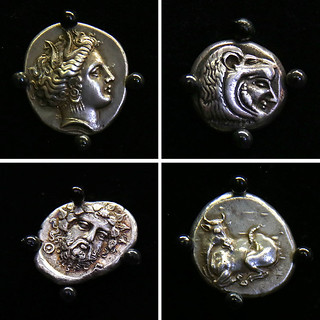 Five ancient Greek coins that had nearly been sold at auction at the Waldorf-Astoria were returned on Monday to the Greek government, ending an unusual prosecution that roiled the coin-collecting world and led to the conviction of a prominent surgeon.
Five ancient Greek coins that had nearly been sold at auction at the Waldorf-Astoria were returned on Monday to the Greek government, ending an unusual prosecution that roiled the coin-collecting world and led to the conviction of a prominent surgeon.
The coins were among 20 rare pieces from the ancient world that the surgeon, Dr. Arnold-Peter Weiss, tried to sell at the Waldorf-Astoria on Jan. 3, 2012.
One of the buyers who approached Dr. Weiss was an informant, who caught him on tape saying he knew that one of the coins he was selling had been recently looted from Sicily.
“There’s no paperwork,” the doctor said, according to a criminal complaint filed by the Manhattan district attorney’s office. “I know this is a fresh coin; this was dug up a few years ago.”
The case never went to trial, but Dr. Weiss’s arrest sent chills through the numismatic world, where state charges for possession of stolen property are extremely rare. In years past, American dealers caught with ancient coins dug up in the modern era of strong patrimony laws in countries like Greece and Italy usually faced civil suits in federal court.
At worse, they risked being forced to forfeit the artifacts to the United States government, which in most cases returned them to the source countries without pursuing criminal charges, experts on cultural property law said. As a result, some dealers were willing to market coins with spotty paperwork and murky histories.
“You could almost call it a landmark case — he did something that was suddenly seen as criminal,” said Ute Wartenberg, the executive director of the American Numismatic Society. “This was like something that could have happened to a whole bunch of people; there was nothing particularly unusual about it.”
To read the complete article, see: Ancient Coins Returned to Greece, Ending U.S. Ordeal (www.nytimes.com/2014/08/05/nyregion/ancient-coins-returned-to-greece-ending-us-ordeal.html?_r=1)
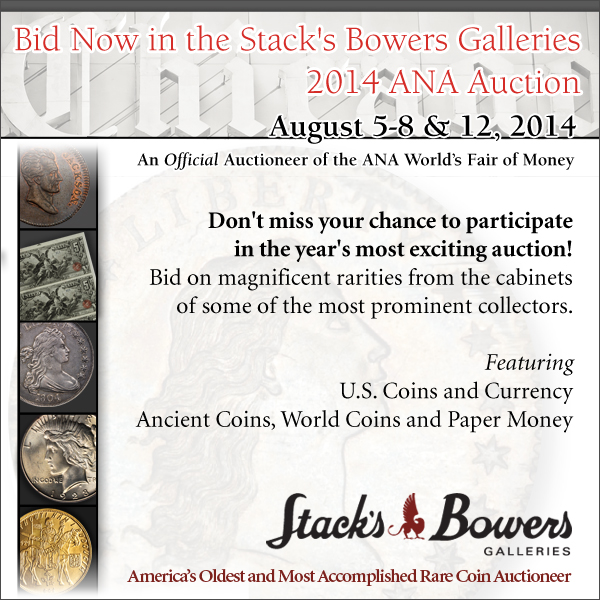
GREAT REVOLT COIN HOARD UNCOVERED IN JERUSALEM
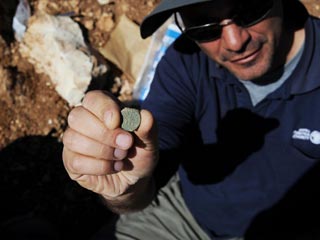 Pottery shards found during construction to widen the Jerusalem-Tel Aviv Highway led archeologists to a previously unknown settlement from the late Second Temple period during the time of Jesus.
Pottery shards found during construction to widen the Jerusalem-Tel Aviv Highway led archeologists to a previously unknown settlement from the late Second Temple period during the time of Jesus.
In one of the houses, archaeologists found a ceramic box containing 114 bronze coins dating to the fourth year of the Great Revolt by the Jews against the Romans before the destruction in 70 AD of the Temple built by King Herod.
Israel Antiquities Authority excavation directors Pablo Betzer and Eyal Marco said the coins appear to have been buried several months prior to the fall of Jerusalem at the end of the rebellion.
"Evidently someone here feared the end was approaching and hid his property, perhaps in the hope of collecting it later when calm was restored to the region," one of the directors explained.
One side of the coins is stamped with a chalice and the Hebrew inscription "To the Redemption of Zion." The motif on the other side, inscribed "Year Four," meaning the fourth year of the Great Revolt, includes a bundle of lulav and two etrogs, used during Sukkot, the Feast of Tabernacles.
The directors found the coin cache in a corner of three-room building with a courtyard. It could have been buried inside a wall or in the floor, they said.
To read the complete article, see: 2,000-Year-Old Coin Cache Uncovered (www.cbn.com/cbnnews/insideisrael/2014/August/2000-Year-Old-Coin-Cache-Uncovered-/)
CONDEMNED FLORIDA HOME SPEWS COINS FROM WALLS
Florida has a long history of buried, lost or sunken treasures.
Most involve shipwrecks and gold doubloons or "Pieces of Eight."
This tale involves a condemned home with a crumbling chimney in a neighborhood once home to Civil War veterans near the shores of East Lake Tohopekaliga.
"The house was full of Florida junk," neighbor Jim Tuck said Friday about the 60 pounds of silver coins discovered in the recently demolished North Minnesota Avenue home. "It was grab, grab, grab and then talk, talk, talk."
Stored for decades inside the walls, large glass pickle jars holding the more than 2,000 coins shattered when a crew of St. Cloud city workers leveled 1915 bungalow on April 22.
At least one large construction Dumpster had been removed before a member of the crew kept hearing the sound of metal pouring out of the walls.
"It was like a treasure hunt … the more you dug the more you found," said Melissa Howes of city code enforcement, laughing about the scramble to find more. "We thought we might be able to keep it like finders keepers, but it was city property."
Nothing was announced publicly, but rumors began circulating month ago.
This week, police Chief Pete Gauntlett showed off the coins that have been stored in police evidence.
City officials had been waiting to see whether anyone would come forward claiming ownership, he said.
The booty included 861 half dollars, 1,016 quarters, 202 dimes and three nickels, police records show.
The oldest spotted among the half dollars was dated 1917 and the most recent was a 1964 Kennedy half dollar.
The last owner of the house, Lamarr LoMax Lowe, abandoned it last year after failing to pay $511,500 in code-enforcement liens including daily $250 fines for more than 10 years, according to city records.
A former Walt Disney World employee, Lowe bought the 776-square-foot house in 1991 for $39,900.
Prior to abandoning the house last year, neighbors said Lowe lived there for months without water or electricity...
To read the complete article, see: Thousands of silver coins discovered in condemned St. Cloud house (articles.orlandosentinel.com/2014-08-08/news/os-silver-dollars-chimney-st-cloud-20140808_1_silver-coins-chief-pete-gauntlett-treasure)
SMITHSONIAN INSTITUTION FOUNDED IN 1846
On this day in 1846, Congress passed an act establishing The Smithsonian Institution. When the English mineralogist James Smithson died in 1829, he left his large fortune to the United States, stipulating that it be used to "increase and diffuse knowledge among men." The money was shipped to the United States in 105 bags, each containing a thousand sovereigns — a total of about $500,000. The Smithsonian Institution now comprises 15 different museums, including the National Museum of Natural History, the National Portrait Gallery, the Cooper-Hewitt National Design Museum, the Hirshhorn Museum of modern art, and the National Zoo.
For more information on Smithsonian history, see: History of the Smithsonian (newsdesk.si.edu/about/history/)
To read the complete article, see: he Writer's Almanac for August 10, 2014 (writersalmanac.publicradio.org/index.php?date=2014/08/10)
FEATURED WEB PAGE: NATIONAL NUMISMATIC COLLECTION
This week's Featured Web Page is the National Numismatic Collection (NNC) of the Smithsonian Institution.
Located in the National Museum of American History, Behring Center, the NNC includes approximately 1.6 million objects. There are over 450,000 coins, medals and decorations and 1.1 million pieces of paper money (including the recently acquired “Confederate Treasury horde” of cancelled Confederate paper money) in the collection, highlighting the entire numismatic history of the world.

http://americanhistory.si.edu/numismatics/
